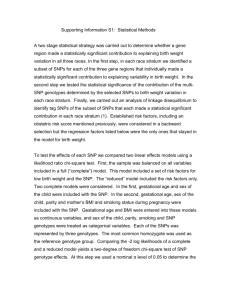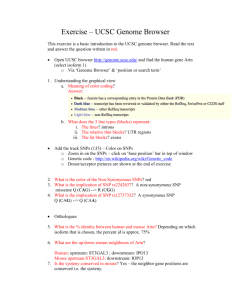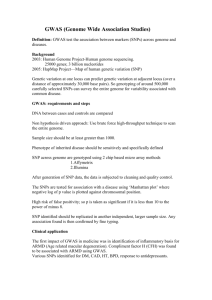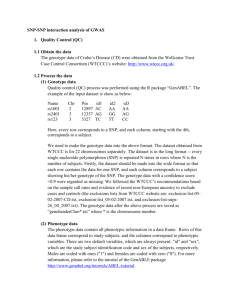Personalized Medicine Background and Challenges Geoffrey S
advertisement
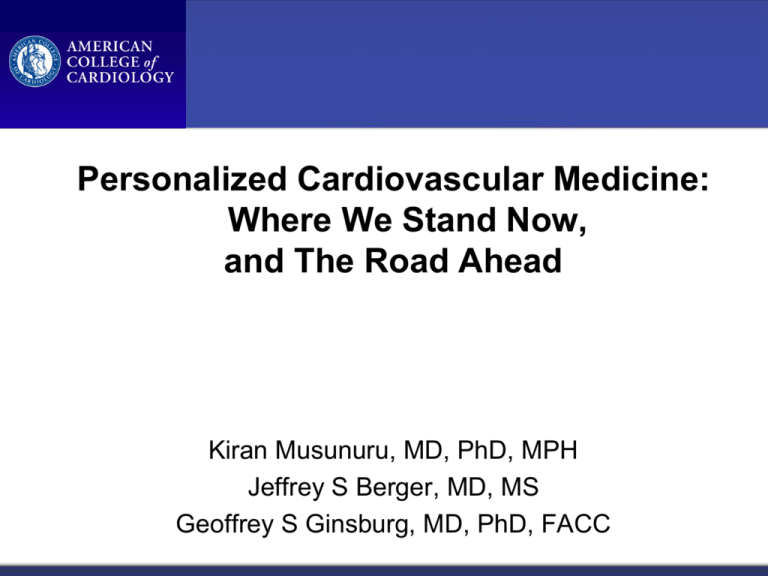
Personalized Cardiovascular Medicine: Where We Stand Now, and The Road Ahead Kiran Musunuru, MD, PhD, MPH Jeffrey S Berger, MD, MS Geoffrey S Ginsburg, MD, PhD, FACC Personalized Medicine: Definition “Personalized medicine is the use of diagnostic and screening methods to better manage the individual patient’s disease or predisposition toward a disease…. “Personalized medicine will enable risk assessment, diagnosis, prevention, and therapy specifically tailored to the unique characteristics of the individual, thus enhancing the quality of life and public health.” – NHLBI Strategic Planning, Theme #10 Disclaimer Personalized medicine remains a research concept – it is not yet ready for clinical practice! Addressing the Complexity of Cardiovascular Disease Metabolic pathways Gene expression profile Standard Biochemical Pathway GCCCACCTC CGGGTGGAG GCCCACCUC DNA (genome) RNA (transcript) metabolites protein (e.g., enzyme) A New Biomarker Toolbox: Shift to Personalized Care Human Genome Sequence (Genomics) Polymorphisms ~ 10,000,000 Gene Expression Profiles (Transcriptomics) Microarrays of ~ 25,000 gene transcripts Proteome (Proteomics) Protein arrays of specific protein products ~ 100,000 Metabolome (Metabolomics) Small molecule metabolites ~ 5000 The Challenge Individuals with personal profile A Two different “phenotypes” – i.e., survival rates Individuals with personal profile B Example: Gene Expression Profiling Concept of “Biosignature” Cardiovascular Insult or Therapy Patient A Patient B “Biosignatures” Gene chips Outcome A Outcome B The Path to Personalized Medicine Standard of Care (A or B) Random Selection A or B Outcome “Omics”-guided A or B Outcome A B Health and Economic Outcomes Genomics – Definitions Polymorphism – an area of DNA sequence that varies from person to person “Single nucleotide polymorphism” (SNP) – a polymorphism in which a single base in the DNA differs from the usual base at that position “Copy number variant” (CNV) – a polymorphism in which the number of repeats of a DNA sequence at a location varies from person to person “Indel” – a polymorphism in which a DNA sequence is either present (insertion) or absent (deletion) at a location, varying from person to person Types of Polymorphisms GCCCACCTC CGGGTGGAG Single Nucleotide Polymorphism (SNP) GCCCGCCTC CGGGCGGAG GCCCACCTCCTC CGGGTGGAGGAG Copy Number Variant (CNV) GCC CTC CGG GAG “Indel” Polymorphism More Definitions “Locus” is the local area on a chromosome around a SNP “Genotype” is the identity of the base at a SNP position for each of the two alleles (since humans have paired chromosomes) – a genotype is always two letters, unless the SNP is on the X or Y chromosome in a man (XY) “Haplotype” is a combination of SNPs at multiple linked loci that are usually transmitted as a group from parent to child Chromosomal Locus (1) X A B C D E Y gene hotspot hotspot Groups of SNPs are separated by recombination “hotspots” – the SNPs tend to be passed from parents to children as a unit, called a “linkage disequilibrium” block Thus, SNPs A, B, C, D, E tend to stay together as a group – the bases at these SNPs make up a “haplotype” – whereas SNPs X and Y are not linked (not in linkage disequilibrium) Because SNPs A–E are all linked, only one of these SNPs is needed to act as a “tag” SNP for the whole group Chromosomal Locus (2) X A B C D E Y gene hotspot hotspot Even though (in this example) SNPs A, B, C, and E are not in the gene, each is in “linkage disequilibrium” with the gene and remains associated with the gene as it is passed from parents to children If the gene causes a particular outcome (e.g., higher risk for a disease), SNPs A–E will be associated with that outcome This is the basis for genome wide association studies Genome Wide Association Studies (GWAS) “HapMap” is an international consortium that has identified millions of SNP locations in the human genome Genome wide association studies (GWAS) in the HapMap era: Identify an optimal set of ~ 300,000 “tag” SNPs (to adequately cover genome of 3,000,000,000 bases) Collect > 1000 cases (e.g., a disease, a successful response to a therapy, etc.) and > 1000 controls Genotype all case/control DNAs for all tagging SNPs 600 million – not 6 trillion for full genomes – genotypes @ $0.005/genotype = ~ $3 million for each disease (but cost is falling rapidly) GWAS to Find OutcomeAssociated SNPs (1) Outcome 1 (cases) A1 A1 A2 A1 A1 G1 G1 G2 G1 G1 Outcome 2 (controls) A2 A2 A2 A1 A2 G2 G2 G2 G1 G2 Association between SNP variant A1 / gene variant G1 and outcome 1 GWAS to Find OutcomeAssociated SNPs (2) Outcome 1 (cases) B1 B1 B2 B1 B2 G1 G1 G2 G1 G2 Outcome 2 (controls) B1 B2 B1 B1 B2 G1 G2 G1 G1 G2 No association between SNP variant B1 / gene variant G1, and outcome 1 Uses for the Results of GWAS human genome Genome to genes ~3,000,000,000 bases chromosomal loci – SNPs ~100,000 bases causal genes risk prediction (epidemiology) 1 3 function (basic science) pharmacogenomics 2 4 therapy (drug development) SNPs for Risk Prediction SNP 1 GCCCGCCTC = AA (+0) vs. GA (+1) vs. GG (+2) GCCCACCTC SNP 2 SNP 3 . . . SNP n Total risk score . . . . . . . = ?? (+0) vs. ?? (+1) vs. ?? (+2) = ?? (+0) vs. ?? (+1) vs. ?? (+2) . . . = ?? (+0) vs. ?? (+1) vs. ?? (+2) = X (low risk vs. medium vs. high) Genetic Risk Score for Cardiovascular Disease A genetic risk score calculated with 9 SNPs associated with LDL or HDL cholesterol (score from 0-18) is associated with cardiovascular disease However, the score does not add to traditional risk factors for CVD risk prediction From Kathiresan et al., N Engl J Med, 2008: 358,1240-1249 SNP Panels for Risk Prediction – Pitfalls Several companies are marketing SNP panels to the general public, charging hundreds to thousands of $$$ The premise for these panels is that they will let patients know if they are at higher risk for particular diseases None of these panels have yet been shown to add value to traditional risk factor algorithms, and they should not be recommended to patients at this time The panels do not include rare mutations that cause disease Because all genome-wide studies to date have been done in Caucasian populations, the SNP panels are not relevant to non-Caucasian individuals Pharmacogenomics – Gene-Based Clinical Trial Randomization Control group CYP2C9 genotype VKORC1 haplotype Endpoints Usual practice of prescribing warfarin Time to adequate INR Warfarin dose adjusted to genotype/haplotype Complications – bleeds, hospitalization Warfarin Resistance and Sensitivity Pharmacogenomics – Mixed Success for Warfarin Formula for dosing: Estimated weekly coumadin dose = 1.64 + expe[3.984 + *1*1(0) + *1*2(-0.197) + *1*3(-0.360) + *2*3(-0.947) + *2*2(-0.265) + *3*3(-1.892) + Vk-CT(-0.304) + Vk-TT(-0.569) + Vk-CC(0) + age(-0.009) + male sex(0.094) + female sex(0) + weight in kg(0.003)] where expe is the exponential to base e; *1, *2, *3 refer to CYP2C9 wild-type (*1) or variant (*2, *3) genotypes, respectively; and Vk refers to VKORC1 with variants CT, TT, or CC In an early clinical trial, use of this formula improved the accuracy and efficiency of warfarin initiation, though it did not significantly reduce out-of-range INRs From Anderson et al., Circulation, 2007: 116,2563-2570 Pharmacogenomics – Mixed Success for Warfarin The International Warfarin Pharmacogenetics Consortium (IWPC) used a large retrospective study of warfarin users to develop an algorithm to predict weekly dosing of warfarin The algorithm includes age, height, weight, race, CYP2C9 genotype, VKORC1 haplotype, and use of interacting medications (amiodarone, statins, azoles, sulfa drugs) The IWPC tested the algorithm in a (retrospective) validation cohort of warfarin users, comparing with a fixed-dose approach and a clinical algorithm (i.e., no genetics information) From The International Warfarin Pharmacogenetics Consortium, N Engl J Med, 2009: 360,753-764 Pharmacogenomics – Mixed Success for Warfarin For most patients, there was no predictive advantage to the pharmacogenetic algorithm However, for outliers—patients requiring low or high doses of warfarin to maintain stable INR—the pharmacogenetic algorithm was significantly better Algorithms such as this one need to be validated in prospective clinical trials From The International Warfarin Pharmacogenetics Consortium, N Engl J Med, 2009: 360,753-764 Pharmacogenomics – Response to Clopidogrel The cytochrome P-450 2C19 enzyme converts clopidogrel into its active metabolite CYP2C19 was genotyped in subjects of 3 large studies of post-ACS patients receiving clopidogrel In all 3 studies, carriers of reduced-function CYP2C19 alleles had increased death, subsequent MI, and stroke Will this be clinically useful? Pharmacogenomics – Statin-Induced Myopathy GWAS of statin-induced myopathy found SNP in SLCO1B1 gene associated with the condition Individuals with CC genotype have 17 times higher risk of myopathy than those with TT May be useful for predicting risk before starting statin therapy—needs to be tested in clinical trial From The SEARCH Collaborative Group, N Engl J Med, 2008: 359,789-799 Candidate Genes for Lipid Traits from Genomic Studies GCCCGCCTC lipid level GCCCACCTC lipid level LDL HDL Triglycerides APOB ABCA1 APOA cluster APOE cluster CETP ANGPTL3 LDLR LIPC MLXIPL HMGCR LIPG GCKR PCSK9 LPL TRIB1 CSPG3 GALNT2 SORT1 MVK From: (1) Willer et al., Nat Genet 2008: 40,161-169; (2) Kathiresan et al., Nat Genet 2008: 40,189-197; (3) Kooner et al., Nat Genet 2008: 40,149-151; (4) Sandhu et al., Lancet 2008: 371,483-491 Candidate Genes for CAD/MI from Genomic Studies Myocyte Enhancer Factor 2A (MEF2A) Wang et al., Science 2003: 320,1578-81 5-lipoxygenase activating protein (FLAP) Helgadottir et al., Nat Genet 2004: 36, 233-239 GATA-2 Connelly et al., PLOS Genet 2006: 2, 1265-1273 Chromosome 9p21 (gene not known) Samani et al., N Engl J Med 2007: 357, 443-453 What to Expect Although there are no applications of personalized medicine being routinely used in cardiology yet, examples from other specialties suggest what’s on the horizon E.g., HLA-B*5701 allele testing is now done before abacavir therapy to reduce the risk of hypersensitivity reactions Genetic counselors will play an increasingly important role in patient management as genetic information becomes incorporated into everyday clinical practice Referrals to genetic counselors are encouraged; if no counselors are available at one’s institution, local counselors can be found through the website: www.nsgc.org Conclusion We look to a future in which medicine will be predictive, preventive, preemptive and personalized
